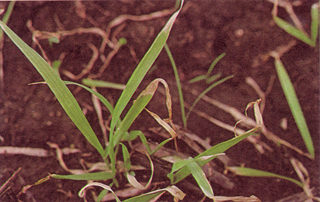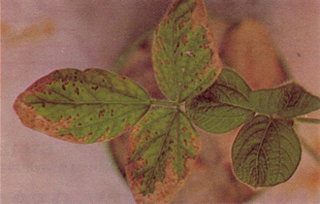G1891
A Quick Test for Herbicide Carry-over in the Soil
How can you tell if you have herbicide carry-over in your fields? Plants grown in soil samples can tell.
Robert N. Klein, Extension Cropping Systems Specialist
Mark L. Bernards, Extension Irrigated Weeds Specialist
Patrick J. Shea, Professor School of Natural Resources
- The Bioassay
- Obtaining a Representative Soil Sample
- Preparing Soils for the Bioassay
- Planting and Growing Bioassay Species
- Typical Herbicide Injury Symptoms
|
Herbicide residues may persist in the soil and affect susceptible crops for one or more years following application. Crop sensitivity depends on the specific crop-herbicide combination (Figure 1). Herbicide labels often provide guidelines on intervals between herbicide application and the planting of sensitive crops. However, there may be situations where it is important to assess the level of herbicide residue in a soil prior to planting a crop, either because a label does not provide guidelines, or previous experience indicates a potential for injury to occur.
Past attempts to predict herbicide carry-over and the potential to damage sensitive crops have only been partly successful. The rate of herbicide degradation or movement is affected by soil texture, pH, and organic matter content, as well as herbicide application rate and timing, rainfall, and plant growth the previous year.
Herbicide analysis of soils can be done, but is often expensive and may not reveal whether your crop will be injured. An inexpensive and effective way to measure whether herbicide carry-over may affect your crop is a bioassay.
The Bioassay
Biological assays, using test plants similar to the field crop to be grown, are practical and can be done with simple equipment available in most homes or offices. The bioassay does not provide an exact measure of the amount of herbicide present in the soil, but it can show you whether enough remains to harm sensitive crops.
The procedure outlined here was developed for atrazine (AAtrex), a widely used herbicide. Because atrazine is used extensively and is relatively long lasting, some carry-over problems have occurred (Figure 2).
The bioassay procedure also can be used to determine problematic residue levels of other herbicides, such as metribuzin (Sencor/Lexone®), simazine (Princep®), linuron (Lorox), pendimethalin (Prowl®), treflan (Treflan™), isoxaflutole (Balance®), imazaquin (Scepter®), nicosulfuron (Accent®), and others. Injury symptoms and susceptible crops will differ depending on the herbicide in question.
Obtaining a Representative Soil Sample
Herbicide carry-over problems rarely are uniform across a field, but generally occur in patches. Areas where plants frequently show injury from carry-over include field entrances and edges, turnaround areas, eroded knolls, soils with extreme pH, and terrace channels. In short, areas of the field where the soil pH, moisture, organic matter, or herbicide application rate are extreme may be at higher risk of carry-over. You should collect and analyze samples separately from areas where more herbicide residue is expected.
Collect a representative sample of soil from the areas of the field suspected of having herbicide residue. The assay is only as reliable or representative as your sample. A total of 10 lb of moist soil is required for each sample assayed. Soil found in most Nebraska fields weighs about 11 lbs/gallon; loose soil is lighter. The number of cores it takes with various sizes of soil probes to equal 1 lb of soil are as follows:
Probe Diameter (inches) |
Number of Cores in 3 inch depth to equal 1 lb of soil |
1
2 3 |
9 2.2 1 |
Assays should be carried out on moist soil samples within two days after they are obtained from the field. Samples that cannot be assayed immediately should be stored in a freezer. The amount of herbicide residue may decrease due to biological and non-biological breakdown if samples are stored under warm conditions.
Preparing Soils for the Bioassay
Wet soil should be spread out and allowed to partially dry to a workable condition. If the soil is cloddy, crush so the clods are no larger than wheat seed, but do not pulverize. Blend the moist soil together to obtain a uniform sample.
To accurately determine if herbicide residue is responsible for injury seen in the bioassay, it is necessary to prepare a herbicide-free soil, one where there is no herbicide residue or where the residue has been inactivated. One option is to collect a clean soil sample from a garden or fence row where herbicides have not been applied or use a commercial potting mix. The second option is to treat a portion of the soil collected in the field with activated charcoal.
After blending the soil cores together, divide the soil into two equal portions (each about 5 lbs). Add 1 level teaspoon of activated charcoal to half of the soil. Thoroughly mix the charcoal into the soil. Most of the herbicide will be bound to the carbon in the charcoal and will be inactivated, providing a herbicide-free soil for comparison.
Activated carbon or charcoal can be obtained as a non-prescription item at most drug stores for a small charge. Many garden, pet, and hobby shops stock activated charcoal for terrariums. For best results use powdered charcoal. If only granular charcoal is available, it can be powdered by hand prior to use.
Planting and Growing Bioassay Species
Flower pots or half-gallon or larger milk cartons may be used for the bioassay. Use the same kind and size of container for both treatments. If cartons are used, cut them down for planting purposes. Punch holes in the bottoms for drainage. Fill one container using charcoal-treated or herbicide-free soil and another with soil as it came from the field. Properly label each container.
Herbicide injury symptoms on seedlings should become apparent within three weeks after planting seed. Less time is required if high herbicide concentrations are present. It will take longer if the temperature is below 70°F.
To test for atrazine carry-over, plant six beans (soybeans, field beans or garden beans) or 10 oat seeds in each container. (Different species may be required to test for carry-over from other herbicides). Press or punch the seeds no deeper than 1/4 inch into the soil. Plant so there is uniform spacing between the seeds. Thoroughly water the soil. Germinate beans at 72°F. Lower temperatures are satisfactory for oats.
Cover the containers with plastic food wrap until plants begin to emerge from the soil to provide favorable moisture conditions during germination. At emergence, remove the plastic. Water as needed. Do not let the soil dry out.
Keep the containers in a warm place (70 to 75°F) where they will get as much sunlight as possible. Sunlight is essential for the development of injury symptoms from atrazine and many other herbicides. Artificial light has much less intensity than sunlight, so sunlight is preferred.
Soon after emergence, thin the beans to three plants per container by clipping them off at the soil surface. Maintain uniform spacing between the remaining plants. Thinning should be done as soon as possible after emergence to reduce the amount of herbicide removed by discarded plants. It is not necessary to thin the oats.
With too many plants per container, low concentrations of herbicides may not be detected. When large number of plants are present, each plant extracts a very small amount of herbicide from the soil. The amount may be small enough that it is not toxic to the plant. When fewer plants are grown in the same amount of soil each plant may extract more herbicide, and will show injury or die if enough herbicide residue is present. Three bean plants or 10 or fewer oat plants are all that should be used in 5 to 10 lbs of soil because these numbers more nearly approach field conditions, and provide a more accurate indication of low herbicide concentrations.
Typical Herbicide Injury Symptoms
Herbicide injury symptoms will only appear in contaminated soils when moisture, temperature, and light conditions are favorable for the growth of the bioassay species. Specific symptoms depend on the bioassay species and the herbicide in question. In Table I we describe types of injury symptoms one might expect for the major classes of herbicides used in Nebraska. For pictures of these symptoms, please see Practical Weed Science for the Field Scout, (University of Missouri, Extension IPM1007) or Sugarbeet Production Guide EC156.
Plants growing in herbicide-contaminated soil may have one or more of the symptoms described in Table I. In contrast, plants growing in herbicide-free soil (either charcoal treated or uncontaminated) should appear normal. NOTE: If test plants die in both containers, disease could be the cause.
If you have herbicide carry-over
When the bioassay results in herbicide injury to the sensitive species, your crop rotation options are limited to crops that are not sensitive to the herbicide residues. For example, if atrazine symptoms occur, plant the field from which the samples were obtained to an atrazine-tolerant crop such as corn or sorghum. Or, if injury symptoms from fomesafen occur, plant the field to soybean.
This bioassay is an inexpensive and effective way to avoid experiencing crop damage from herbicide carry-over by knowing residues are in your soil that might delay crop development. When you discover herbicide carry-over, you also can plan to avoid the problem by reducing the rate of the offending herbicide in areas where it is less sensitive to degradation.
| Table I. Common injury symptoms on sensitive species. | ||
| Herbicide mode of action | Representative products | Typical injury symptoms on sensitive crop species |
| Growth regulators | 2,4-D, dicamba (Banvel®, Clarity®, Status), clopyralid (Stinger™), fluroxypyr (Starane™) | Broadleaf species: leaf cupping or strapping, stem twisting or epinasty, callus tissue on stems, brittle stems, necrosis of meristematic tissue
Grass species: onion leafing, leaf rolling, brace-root fusion, brittle stems, stalk bending |
| ALS inhibitors | imazaquin (Scepter®), imazethapyr (Pursuit®), chlorimuron (Classic®), thifensulfuron (Harmony®), nicosulfuron (Accent®), flumetsulam (Python®) | Broadleaf species: chlorosis, stunted plants or shortened internodes, red or black veins on underside of leaf Grass species: stunted plants, interveinal chlorosis, purpling of stems and leaves, bottlebrush roots |
| Seedling growth | trifluralin (Treflan), pendimethalin (Prowl®), metolachlor (Dual®), acetochlor (Harness®), dimethenamid (Outlook®) | Broadleaf species: swollen hypocotyls, callus on stem tissue at base of stems, root growth inhibited, inhibitors heart-shaped leaves, rough, crinkled leaves Grass species: stunted, thickened, red or purple in color, may appear drought stressed, “buggy whipping,” onion leafing or improper leaf unfurling |
| Photosynthesis inhibitors | Atrazine (AAtrex®), metribuzin (Sencor®), linuron (Lorox) | Broadleaf species: chlorosis and necrosis at leaf tips and margins; interveinal chlorosis; brown speckling near leaf edges
Grass species: chlorosis and necrosis at leaf tips and margin |
| Cell membrane disruptors | fomesafen (Reflex®/Flexstar®), flumioxazin (Valor®), sulfentrazone (Spartan®) | Broadleaf species: stunting; chlorosis and necrosis; leaf crinkling
Grass species: stunting; veinal chlorosis; necrosis |
| Pigment inhibitors | clomazone (Command®), isoxaflutole (Balance®), mesotrione(Callisto™), topramezone (Impact), tembotrione (Laudis®) | Broadleaf species: white, chlorotic, then necrotic tissue Grass species: translucent, white, chlorotic, then necrotic tissue |
This publication has been peer reviewed.
Disclaimer Reference to commercial products or trade names is made with the understanding that no discrimination is intended of those not mentioned and no endorsement by University of Nebraska–Lincoln Extension is implied for those mentioned. |
Visit the University of Nebraska–Lincoln Extension Publications Web site for more publications.
Index: Pesticides, General
Herbicides
Issued September 2008

